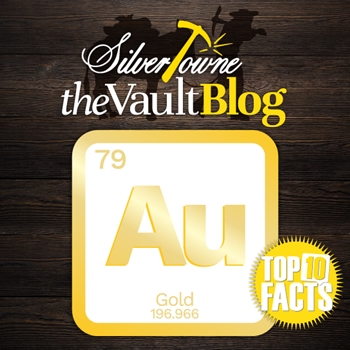
Today’s market is constantly changing, especially with the hand we have been dealt in the face of the COVID-19 pandemic. While precious metals have reached lows and turned into highs we have not seen in a few years, it is important to know about the most popular of elements. Being a leading force in the buying, selling, and production of precious metals and numismatics, it is safe to say that we know a few things.
While we have already covered some of the facts you need to know about silver, we figured that gold was the next best metal to cover. With a periodic symbol of Au, gold has been around for thousands of years.
1. Gold does not oxidize.
In its purest form, gold does not rust unlike silver when exposed to the open air and other elements. It is the most non-reactive of all the metals and will not tarnish after years and years of being exposed.
2. It is a soft metal.
Gold is soft in comparison to a lot of other precious metals and is malleable to the point where it can be hammered down even though it is a solid. When it comes to gold jewelry, it is often mixed with other metals because of how soft it is.
3. Gold is one of the rarest elements.
Whether hard to believe or not, gold is rarer than you think. It is even rarer than diamonds. Pure gold is a heavy and dense atom which makes it hard to produce even in the incredible heat and pressure that makes up the Earth’s chemical processes.
4. It is one of the first metals discovered by man.
Along with copper, gold was one of the first metals to be discovered. Ancient civilizations used gold lavishly more than 5,000 years ago in the Middle East as it was found in its native form and not combined with any other metals.
5. The world’s deepest gold mine is in South Africa.
Measuring 2.5 miles, the deepest gold mine can be found in Mponeng in South Africa. The mine is compared to being as tall (deep) as 10 Empire State Buildings while it is comprised of over 200 miles of tunnels that are longer than the New York subway.
6. China is the world’s number one consumer of gold.
Consuming more than 900 metric tons of gold per year, China imports two-thirds of the gold it uses. It is used for investing, jewelry, and industry. Along with consumption, China also is the number one producer as it produces more than 355 metric tons per year. Various mines can be found throughout the country as large new gold mines have been discovered in recent years.
7. Over 240,000 metric tons of gold have been mined from the Earth since its discovery.
With around 187,000 metric tons of gold produced plus underground reserves of around 57,000 metric tons, over 240,000 metric tons in total has been discovered. Most of the gold has come from China, Australia, and South Africa while the United States currently ranks fourth in gold production.
8. The United States holds most of its gold reserves at Fort Knox.
According to the United States Mint, about half of the Treasury’s stored gold is being held at Fort Knox, accounting for 147.3 million ounces. The Mint, in addition to numbers provided by the Bureau of Fiscal Services, Mint-held gold reserves in November of 2019 totaled 248,046,115.696 ounces between Denver, West Point, Fort Knox, and the Working Stock. This total values at over $10 billion.
9. Owning physical gold can help diversify your financial portfolio.
Along with protecting your wealth, gold is a strengthener to your financial portfolio and pans out better than other precious metals.
10. It is edible in small quantities.
In many countries, gold is added to food gifts and liquors as decoration. It can also be found in some medicines as an ingredient.
Sources: United States Mint; The Gold Bullion Company; American Bullion







